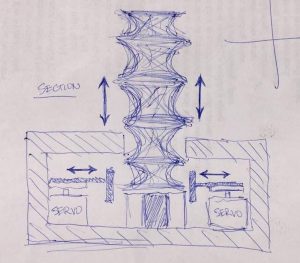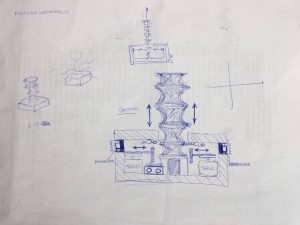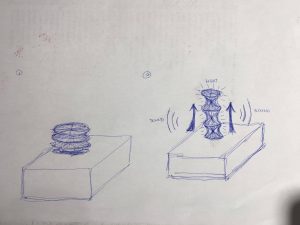Big Idea:
To use the inherent tropes of origami to create dynamic creatures with differing personalities that spark curiosity. It fits well into the museum’s movement based theme.
Why – To generate curiosity
How – Using origami, movement, sound, and light
Abstraction – Living Origami
Audience:
Targeted specifically at kids, but should interest all ages. Interests not only users who interact with these creatures, but also the bystanders who watch the creatures behave. They will probably remember the specific behavioral patterns exhibited by these creatures and potentially have a stronger personal connection with one.
Inspiration:
Madeline Gannon
https://atonaton.com/mimus
References:
https://vimeo.com/80401217
https://www.youtube.com/watch?v=aul0SzPVsls
https://www.youtube.com/watch?time_continue=1&v=YQA2QWebvlc
https://www.pinterest.com/pin/562950022156976275/
Proof Of Concept:

Tasks Division:
Alex: Origami
Ophelie: Behavioral Encoding
Harsh: Mechanics
Ignoring:
Intensive Mechanics in favor or Origami
Test:
Behavior of Creature
Know it works through robustness of movement, sound, and light
Proposal Checklist:
Technical Solution:
Using a 2 Degree system with two hobby servos to push and pull the bottom of the origami piece. The servos, mechanics, and Arduino will rest inside a box which controls the origami, and thus is out of sight to the user.The origami piece expands and contracts based on being compressed or not.
Materials: Paper, MDF, Arduino, Speaker, LED’S, Wood Dowels
Sensors: Sonars, Photoresistors
Actuators: Distance and Light
Algorithms: Servo Rotation Degree and Speed based on Sonar Distance input and Photoresistor Light Input. The Speed will be based on the behavioral trope that we’re encoding into the “creature” and the degree will be calibrated according to the tolerance of the origami.
Key Technical Challenges:
Calibration of Degree of Motion
Calibration of Behavior
Execution of Controlled Motion of Origami
Proof Of Concept:
One creature that has been encoded well with behavior and calibrated to respond to the environment
Objectives for On-Site Test:
Ability to plug in fresh origami piece into mechanism based on breakage.
Observation on response to children- and children’s response to response of creature.
Known-Unknowns:
Generalizing the mechanism to work with different kinds of origami
Specific environmental inputs to encode reactions
Budget Outline:
$10 – MDF
$10 – Origami Paper
$10 – Sensors
$20 – Batteries
If costs go over budget, they will be split equally across the members


Wed-23-Oct: Project Proposal Finalized
Sun-29-Oct: One Origami Creature made, preliminary mechanics work & behavioral testing begins
Fri-10-Nov: One Origami Creature robustly deployed, generic mechanism perfected & behavior worked out.
Fri-17-Nov: Feedback incorporated from tests, One Creature corrected, other creatures are being produced.
Mon-27-Nov: Other Creatures finished, behavior calibrated.
Fri-1-Dec: Calibration Finished. Ready for Museum testing.
Mon-4-Dec: Documentation from Museum Curated
Mon-6-Dec: Final Documentation Finished
Leave a Reply
You must be logged in to post a comment.